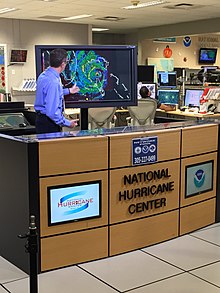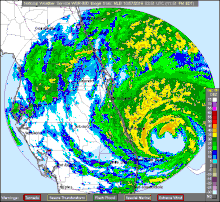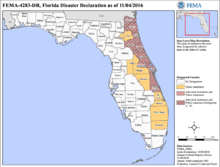
Hurricane Donna, known in Puerto Rico as Hurricane San Lorenzo, was the strongest hurricane of the 1960 Atlantic hurricane season, and caused severe damage to the Lesser Antilles, the Greater Antilles, and the East Coast of the United States, especially Florida, in August–September. The fifth tropical cyclone, third hurricane, and first major hurricane of the season, Donna developed south of Cape Verde on August 29, spawned by a tropical wave to which 63 deaths from a plane crash in Senegal were attributed. The depression strengthened into Tropical Storm Donna by the following day. Donna moved west-northwestward at roughly 20 mph (32 km/h) and by September 1, it reached hurricane status. Over the next three days, Donna deepened significantly and reached maximum sustained winds of 130 mph (210 km/h) on September 4. Thereafter, it maintained intensity as it struck the Lesser Antilles later that day. On Sint Maarten, the storm left a quarter of the island's population homeless and killed seven people. An additional five deaths were reported in Anguilla, and there were seven other fatalities throughout the Virgin Islands. In Puerto Rico, severe flash flooding led to 107 fatalities, 85 of them in Humacao alone.

The 2008 Atlantic hurricane season was the most destructive Atlantic hurricane season since 2005, causing over 1,000 deaths and nearly $50 billion in damage. The season ranked as the third costliest ever at the time, but has since fallen to ninth costliest. It was an above-average season, featuring sixteen named storms, eight of which became hurricanes, and five which further became major hurricanes. It officially started on June 1 and ended on November 30. These dates conventionally delimit the period of each year when most tropical cyclones form in the Atlantic basin. However, the formation of Tropical Storm Arthur caused the season to start one day early. It was the only year on record in which a major hurricane existed in every month from July through November in the North Atlantic. Bertha became the longest-lived July tropical cyclone on record for the basin, the first of several long-lived systems during 2008.

Hurricane Wilma was the most intense tropical cyclone ever recorded in the Atlantic basin, and the second-most intense tropical cyclone recorded in the Western Hemisphere, after Hurricane Patricia in 2015. Part of the record-breaking 2005 Atlantic hurricane season, which included three of the ten most intense Atlantic hurricanes in terms of barometric pressure, Wilma was the twenty-second storm, thirteenth hurricane, sixth major hurricane, fourth Category 5 hurricane, and the second-most destructive hurricane of the 2005 season. Its origins came from a tropical depression that formed in the Caribbean Sea near Jamaica on October 15, headed westward, and intensified into a tropical storm two days later, which abruptly turned southward and was named Wilma. Wilma continued to strengthen, and eventually became a hurricane on October 18. Shortly thereafter, explosive intensification occurred, and in only 24 hours, Wilma became a Category 5 hurricane with wind speeds of 185 mph (298 km/h).

Hurricane Irene produced somewhat heavy damage across southern Florida in October 1999. The ninth named storm and the sixth hurricane of the season, Irene developed in the western Caribbean Sea on October 13 from a tropical wave. It moved northward, hitting western Cuba before attaining hurricane status. Irene struck Florida on October 15 as a Category 1 on the Saffir–Simpson Hurricane Scale, first at Key West and later near Cape Sable. The storm moved across the state and tracked northward over the Gulf Stream. It approached the Carolinas but remained offshore. Irene turned eastward and significantly intensified into a strong Category 2 hurricane on October 18. By the following day, the system became extratropical due to cooler waters to the southeast of Newfoundland and was quickly absorbed by another extratropical low.
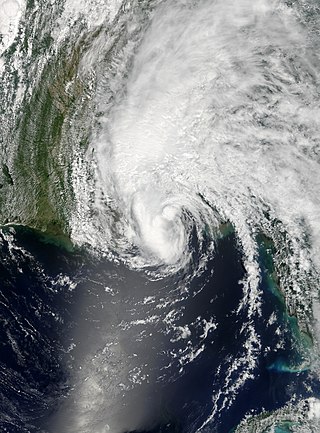
Tropical Storm Arlene was an unusually large and early-forming tropical storm, being the first of twenty-eight different storms during the 2005 Atlantic hurricane season, which would become the second most active season on record. Tropical Storm Arlene formed near Honduras on June 8 and moved northwards. It crossed western Cuba on June 10 and strengthened to just under hurricane strength before making its final landfall on the Florida Panhandle the next day. The storm weakened as it continued to move north over the United States, becoming extratropical on June 13. Arlene was responsible for two deaths and minor damage.

Tropical Storm Leslie was a weak, short-lived tropical cyclone that was never well-organized; however, its precursor was costlier than any other tropical cyclone in the 2000 Atlantic hurricane season. The twelfth named storm of the season, Leslie formed on October 4 over eastern Florida as a subtropical cyclone, out of a trough of low pressure. Strengthening over open waters, it attained enough tropical characteristics to be reclassified as Tropical Storm Leslie on October 5. The storm reached peak winds of 45 mph (75 km/h) before wind shear weakened it, and on October 7 transitioned into an extratropical cyclone over the open Atlantic Ocean. Leslie lasted three more days before losing its identity.
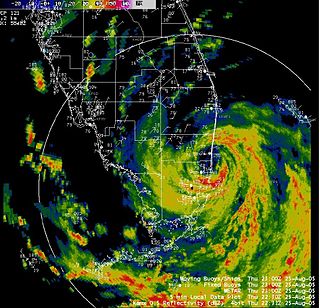
The effects of Hurricane Katrina in Florida were in both the southern portion of the state and in the panhandle. After developing on August 23, Katrina made landfall near the border of Broward and Miami-Dade counties with 80 mph (130 km/h) winds on August 25. While it was crossing the state, the hurricane's convection was asymmetrical, primarily located to the south and east of the center. As a result, high rainfall totals occurred in the Miami area, peaking at 16.43 in (417 mm) in Perrine. The rains caused flooding, and the combination of rains and winds downed trees and power lines, leaving 1.45 million people without power. Damage in South Florida was estimated at $523 million (2005 USD), mostly as a result of crop damage. Further south, the hurricane spawned a tornado in the Florida Keys. In the island chain, Katrina caused heavy rainfall and gusty winds.

Hurricane Andrew was a compact, but very powerful and destructive Category 5 Atlantic hurricane that struck the Bahamas, Florida, and Louisiana in August 1992. It is the most destructive hurricane to ever hit Florida in terms of structures damaged or destroyed, and remained the costliest in financial terms until Hurricane Irma surpassed it 25 years later. Andrew was also the strongest landfalling hurricane in the United States in decades and the costliest hurricane to strike anywhere in the country, until it was surpassed by Katrina in 2005. In addition, Andrew is one of only four tropical cyclones to make landfall in the continental United States as a Category 5, alongside the 1935 Labor Day hurricane, 1969's Camille, and 2018's Michael. While the storm also caused major damage in the Bahamas and Louisiana, the greatest impact was felt in South Florida, where the storm made landfall as a Category 5 hurricane, with 1-minute sustained wind speeds as high as 165 mph (266 km/h) and a gust as high as 174 mph (280 km/h). Passing directly through the cities of Cutler Bay and Homestead in Dade County, the hurricane stripped many homes of all but their concrete foundations and caused catastrophic damage. In total, Andrew destroyed more than 63,500 houses, damaged more than 124,000 others, caused $27.3 billion in damage, and left 65 people dead.

The effects of Hurricane Isaac in Florida were severe local flooding in South Florida and tornadoes in Central and Northern Florida in August 2012. Hurricane Isaac formed from a tropical wave while located east of the Lesser Antilles on August 21, 2012. The storm moved westward, crossed through the Leeward Islands, and entered the Caribbean Sea on August 22. Isaac initially struggled to intensify and defied predictions of it strengthening into a hurricane. The storm made its first landfall in Haiti as a midgrade tropical storm prior to making a second one in Cuba later that day. It remained somewhat disorganized while moving through the Straits of Florida and passed near the Florida Keys on August 27. The storm threatened to strike the Tampa Bay Area during the 2012 Republican National Convention and move ashore in the Florida Panhandle as a major hurricane. However, it continued northwestward and avoided landfall in the state. The storm finally became a hurricane late on August 28. Isaac made two landfalls in Louisiana on August 29, the first near the mouth of the Mississippi River and the other near Port Fourchon. The storm steadily weakened and eventually dissipated over Missouri on September 1.

Tropical Storm Andrea brought flooding to Cuba, the Yucatan Peninsula, and portions of the East Coast of the United States in June 2013. The first tropical cyclone and named storm of the annual hurricane season, Andrea originated from an area of low pressure in the eastern Gulf of Mexico on June 5. Despite strong wind shear and an abundance of dry air, the storm strengthened while initially heading north-northeastward. Later on June 5, it re-curved northeastward and approached the Big Bend region of Florida. Andrea intensified and peaked as a strong tropical storm with winds at 65 mph (105 km/h) on June 6. A few hours later, the storm weakened slightly and made landfall near Steinhatchee, Florida later that day. It began losing tropical characteristics while tracking across Florida and Georgia. Andrea transitioned into an extratropical cyclone over South Carolina on June 7, though the remnants continued to move along the East Coast of the United States, until being absorbed by another extratropical system offshore Maine on June 10.

Tropical Storm Erika was one of the deadliest and most destructive natural disasters in Dominica since Hurricane David in 1979. The fifth named storm of the 2015 Atlantic hurricane season, Erika developed from a westward-moving tropical wave while well east of the Lesser Antilles. Hostile conditions, including dry air and wind shear, inhibited significant development, and Erika failed to acquire sustained winds beyond 50 mph (80 km/h). Contrary to predictions of a northwesterly recurvature, the cyclone persisted on a westerly course and passed through the Leeward Islands and emerged over the Caribbean Sea on August 27. Erika succumbed to adverse conditions the following day, dissipating as a tropical cyclone near the Dominican Republic. The remnant system persisted for several more days, moving into the northeastern Gulf of Mexico, before dissipating over Georgia on September 3.

Hurricane Floyd in 1999 threatened Florida as a major hurricane roughly three times as large as Hurricane Andrew. Floyd originated from a tropical wave well east of the Lesser Antilles on September 7. While approaching the Bahamas, the storm strengthened significantly between September 12 and September 13. On the latter day, Floyd peaked as a strong Category 4 hurricane on the Saffir–Simpson scale. However, upon moving closer to the Bahamas, the storm fluctuated in intensity between a Category 3 and a Category 4 hurricane. A subtropical ridge eroded by a mid- to upper-tropospheric trough over the eastern United States caused Floyd to curve northwestward over the Abaco Islands and later to northeast, avoiding a potentially catastrophic landfall in Florida. The storm made its closest approach to Florida early on September 15, passing about 110 mi (180 km) east of Cape Canaveral.
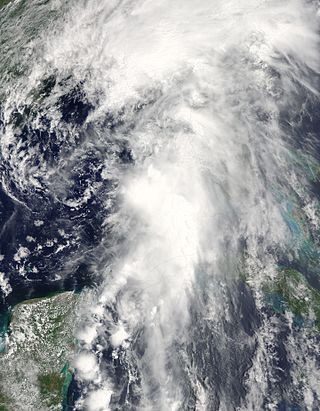
Tropical Storm Colin was the earliest third named storm in the Atlantic basin on record for four years, until it was surpassed by Tropical Storm Cristobal in 2020. An atypical, poorly organized tropical cyclone, Colin developed from a low pressure area over the Gulf of Mexico near the northern coast of the Yucatán Peninsula late on June 5, 2016. Moving northward, the depression strengthened into a tropical storm about eight hours after its formation. On June 6, Colin curved to the north-northeast and intensified slightly to winds of 50 mph (80 km/h). Strong wind shear prevented further strengthening and resulted in the system maintaining a disheveled appearance on satellite imagery. Later, the storm began accelerating to the northeast. Early on June 7, Colin made landfall in rural Taylor County, Florida, still at peak intensity. The system rapidly crossed northern Florida and emerged into the Atlantic Ocean several hours later. By late on June 7, Colin transitioned into an extratropical cyclone offshore North Carolina before being absorbed by a frontal boundary the following day.

Hurricane Matthew was an extremely powerful Atlantic hurricane which caused catastrophic damage and a humanitarian crisis in Haiti, as well as widespread devastation in the southeastern United States. The deadliest Atlantic hurricane since Hurricane Stan in 2005, and the first Category 5 Atlantic hurricane since Felix in 2007, Matthew was the thirteenth named storm, fifth hurricane and second major hurricane of the 2016 Atlantic hurricane season. It caused extensive damage to landmasses in the Greater Antilles, and severe damage in several islands of the Bahamas which were still recovering from Joaquin, which had pounded the archipelago nearly a year earlier. Matthew also approached the southeastern United States, but stayed just offshore, paralleling the Florida coastline.

Tropical Storm Emily was a rapidly-forming tropical cyclone that made landfall on the west coast of Florida. The fifth named storm of the 2017 Atlantic hurricane season, Emily formed from a small area of low pressure that developed along a cold front in late July 2017. Unexpectedly, the low rapidly organized and strengthened into a tropical depression on July 30, and then into a tropical storm early the next day. Emily continued to intensify as it moved eastward, peaking with maximum sustained winds of 60 mph (95 km/h) as it made landfall near Longboat Key on the western Florida coast. The cyclone weakened quickly into a tropical depression shortly after landfall as its circulation became increasingly disrupted. Emerging into the Atlantic Ocean on August 1, Emily continued to weaken as it accelerated northeastward, becoming post-tropical early on August 2.

Hurricane Irma was the costliest tropical cyclone in the history of the U.S. state of Florida, before being surpassed by Hurricane Ian in 2022. Irma developed from a tropical wave near the Cape Verde Islands on August 30, 2017. The storm quickly became a hurricane on August 31 and then a major hurricane shortly thereafter, but would oscillate in intensity over the next few days. By September 4, Irma resumed strengthening, and became a powerful Category 5 hurricane on the following day. The cyclone then struck Saint Maarten and the British Virgin Islands on September 6 and later crossed Little Inagua in the Bahamas on September 8. Irma briefly weakened to a Category 4 hurricane, but re-intensified into a Category 5 hurricane before making landfall in the Sabana-Camagüey Archipelago of Cuba. After falling to Category 3 status due to land interaction, the storm re-strengthened into a Category 4 hurricane in the Straits of Florida. Irma struck Florida twice on September 10 – the first as a Category 4 at Cudjoe Key and the second on Marco Island as a Category 3. The hurricane weakened significantly over Florida, and was reduced to a tropical storm, before exiting the state into Georgia on September 11.

Tropical Storm Claudette was a weak tropical cyclone that caused heavy rain and tornadoes across the Southeastern United States in June 2021, leading to severe damage. The third named storm of the 2021 Atlantic hurricane season, Claudette originated from a broad trough of low pressure over the Bay of Campeche on June 12. The disturbance moved erratically over the region for the next several days, before proceeding northward with little development due to unfavorable upper-level winds and land interaction. Despite this, the National Hurricane Center (NHC) initiated advisories on it as a Potential Tropical Cyclone late on June 17, due to its imminent threat to land. The disturbance finally organized into Tropical Storm Claudette at 00:00 UTC on June 19 just before landfall in southeast Louisiana. Claudette weakened to a depression as it turned east-northeastward before moving through Mississippi, Alabama, Georgia, and South Carolina. Baroclinic forcing then caused Claudette to reintensify into a tropical storm over North Carolina early on June 21 before it accelerated into the Atlantic Ocean later that day. Soon afterward, it degenerated into a low-pressure trough on the same day, before being absorbed into another extratropical cyclone on the next day.

Hurricane Ian was a deadly and extremely destructive Category 5 Atlantic hurricane, which was the third-costliest weather disaster on record worldwide, the deadliest hurricane to strike the state of Florida since the 1935 Labor Day hurricane, and the strongest hurricane to make landfall in Florida since Michael in 2018. Ian caused widespread damage across western Cuba, Florida, and the Carolinas. Ian was the ninth named storm, fourth hurricane, and second major hurricane of the 2022 Atlantic hurricane season. Ian was the first Category 5 hurricane in the Atlantic since Lorenzo in 2019.

Hurricane Nicole was a sprawling late-season Category 1 hurricane in November 2022. The fourteenth named storm and eighth hurricane of the 2022 Atlantic hurricane season, Nicole formed as a subtropical cyclone on November 7, from a non-tropical area of low pressure near the Greater Antilles, and transitioned into a tropical cyclone the next day. Then, taking a path similar to that of Hurricane Dorian three years earlier, Nicole made landfall on November 9, on Great Abaco and on Grand Bahama in The Bahamas, where it strengthened into a Category 1 hurricane. On November 10, it made landfall twice in Florida, south of Vero Beach and then northwest of Cedar Key, after briefly emerging over the Gulf of Mexico. Nicole then weakened to a depression while moving over the Florida Panhandle, and then was absorbed into a mid-latitude trough and cold front over extreme eastern Tennessee the following day.


